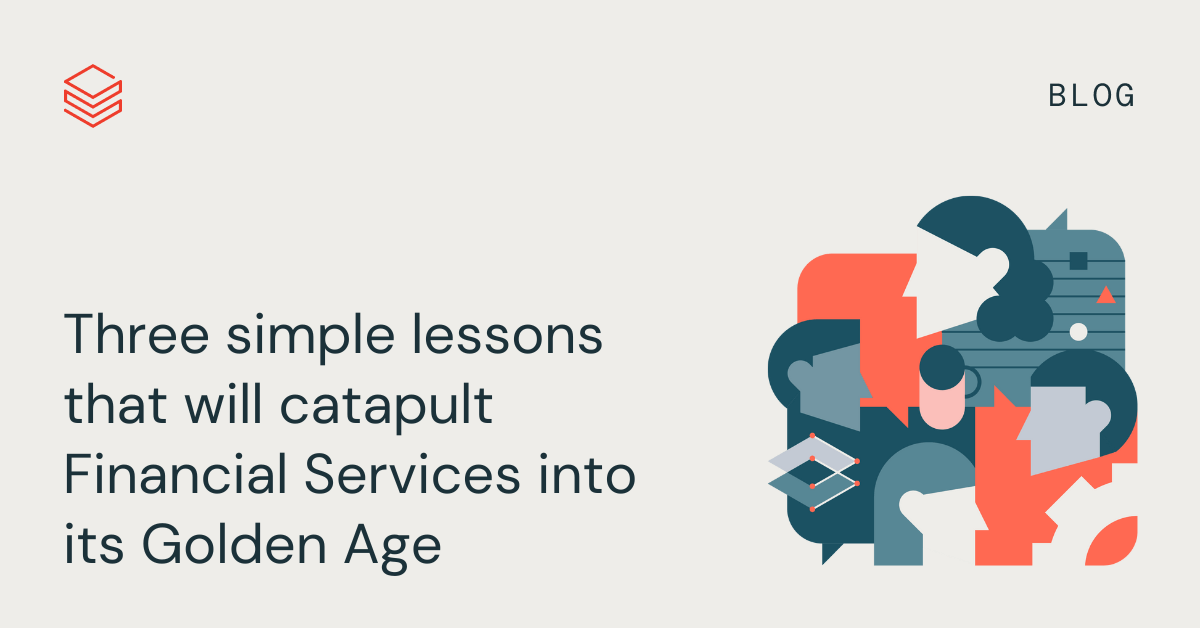Three simple lessons that will catapult financial services into its golden age
Top takeaways from the Databricks Financial Services Symposium

Published: April 21, 2023
by Junta Nakai, Millie Lapidario and Anna Cuisia
Register now for the virtual replay
Imagine a retail bank funding home loans in minutes. Or an insurer underwriting with 200 billion parameters. Or an investment bank delivering personalized equity research — not just to its top hedge funds but to its millions of customers.
Sounds thrilling, but for financial institutions struggling with vast amounts of data, perhaps these scenarios feel out of reach. You’re ready and willing. But are you able?
Hear how some of the most innovative financial institutions are making huge strides in data, analytics and AI. The Databricks Financial Services Symposium in New York City, held on March 8, brought together leaders like Mastercard, Everest Re, Galaxy Digital, Morgan Stanley, Goldmans Sachs, Guy Carpenter and Deloitte. In case you missed it, register here to watch the on-demand replay.
Until then, here are three simple — yet powerful — lessons that echoed throughout the event. Dive deeper into these topics when you join us virtually for the talks, fireside chats and demos.
No. 1: Connect your data strategy to business outcomes
Before building out capabilities, make sure your team clearly understands the business purpose.
Jojy Mathew, Principal at Deloitte Consulting LLP, encourages data leaders to ask basic questions like, “What is the business trying to achieve? And what data do you need for that? What are their use cases?”
For Mastercard, the critical question is “Can we enable a product?” Without answering that question, Mastercard’s VP of Data Strategy John Derrico cautioned, you could be stuck with a capability you’d have to find a user for.
Focus on the use cases that people throughout your organization care about. At Everest Re, their approach to building technology for use cases has not only garnered support from leadership but is also building momentum. “For example, we started to build data quality at the very beginning when we started with the use case of a claim severity model,” Everest Re’s Deputy CIO Arron Lamp says. He continues, “It's like a race now. People are getting things that they haven't gotten before. They're excited about it . . . And that momentum is driving demand.”
No. 2: Build in data quality, data governance and security from the beginning — not as an afterthought
In order to do more with data and AI, financial institutions need deep insights into what their customers require, and must understand how to optimize the business in real-time while managing risk — which is why it’s important to examine digital trust.
“When we have it, it doesn't feel like it's of much value,” said Databricks VP, Field CISO Omar Khawaja says. “But the moment we lose it, the loss that we get from it, the harmful downside to our business, to our organization, to our individual self is significantly greater than the upside we were realizing when we had it.”
At Deloitte, Mathew says he advises clients that data governance, data quality, and metadata management are not optional. “Right from the get-go as you modernize to the cloud, as you implement Databricks Lakehouse, embed that into how you build your data platform.” He added that by allocating 20%-30% of funding for programs toward data governance will ultimately save you millions of dollars down the road.
No. 3: To change the data culture, start by thinking about your stakeholders’ perspectives
Changing the data culture is hard for most organizations. When stakeholders are accustomed to having their analytics and actuarial teams use legacy technologies like Excel, convincing them to modernize can be an uphill climb.
For Guy Carpenter, the data culture is evolving “one tribe at a time,” according to its Head of Data Strategy, Alan Anders.
“I sometimes joke with my team that there's a war map,” Anders says. “And you can almost put data characteristics on each tribe and say, ‘Can we innovate for them today?’ The answer can very often be ‘no.’ And the map is just full of ‘nos.’ And there's one ‘yes.’ And then you move in, and you achieve your outcome. And then some more ‘yeses’ pop up.”
At Everest Re, changing the data culture started by transforming the operating model. Lamp describes how they’ve opened up their self-service environment to be able to do business development. The collaboration goes well beyond IT building infrastructure and sharing, governing and securing data.
“A lot of the code we're doing right now is actually co-developed,” Lamp says. “It's actually written by the business, code reviewed by us and promoted. And back and forth.”
In this new kind of culture, Lamp says, “everyone is going to write code — and it's not just allowed, it’s expected.”
Watch the Databricks Financial Services Symposium Virtual Replay and register for Data and AI Summit 2023, the premier event for the global data, analytics and AI community from June 26-29 in San Francisco.
Never miss a Databricks post
What's next?

Data Science and ML
October 1, 2024/10 min read
ICE/NYSE: Unlocking Financial Insights with a Custom Text-to-SQL Application

Product
November 27, 2024/6 min read
